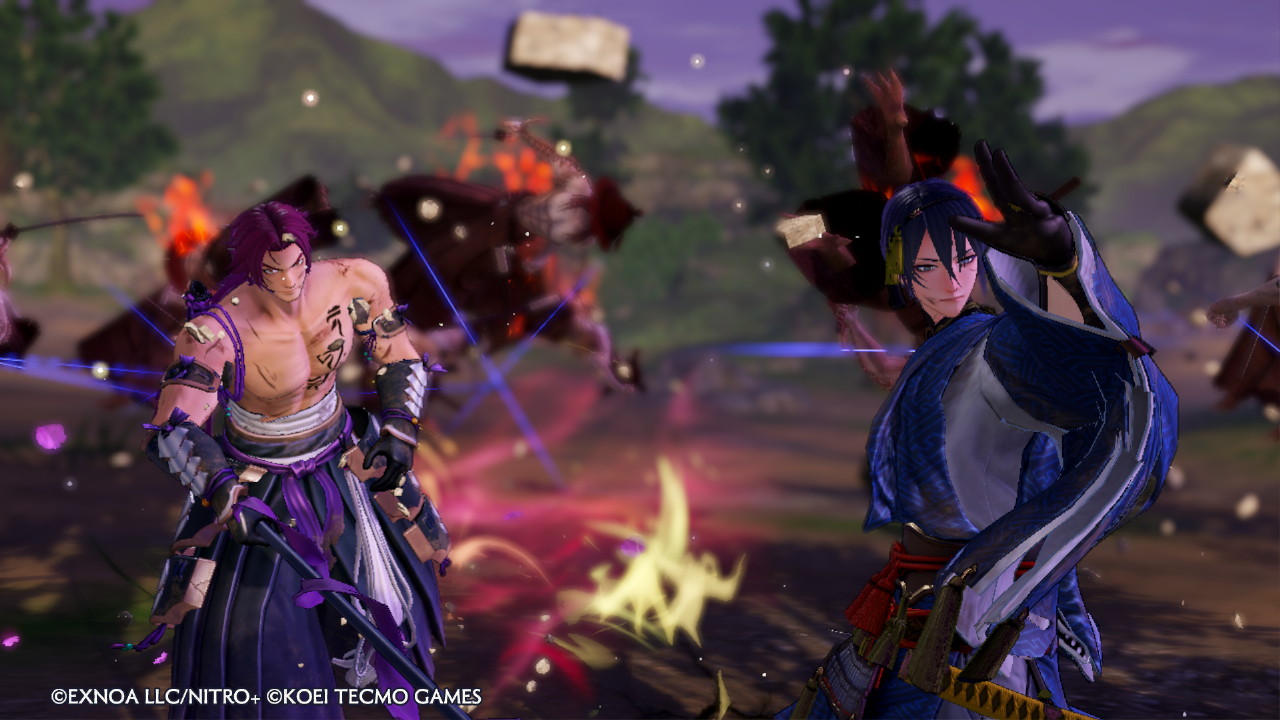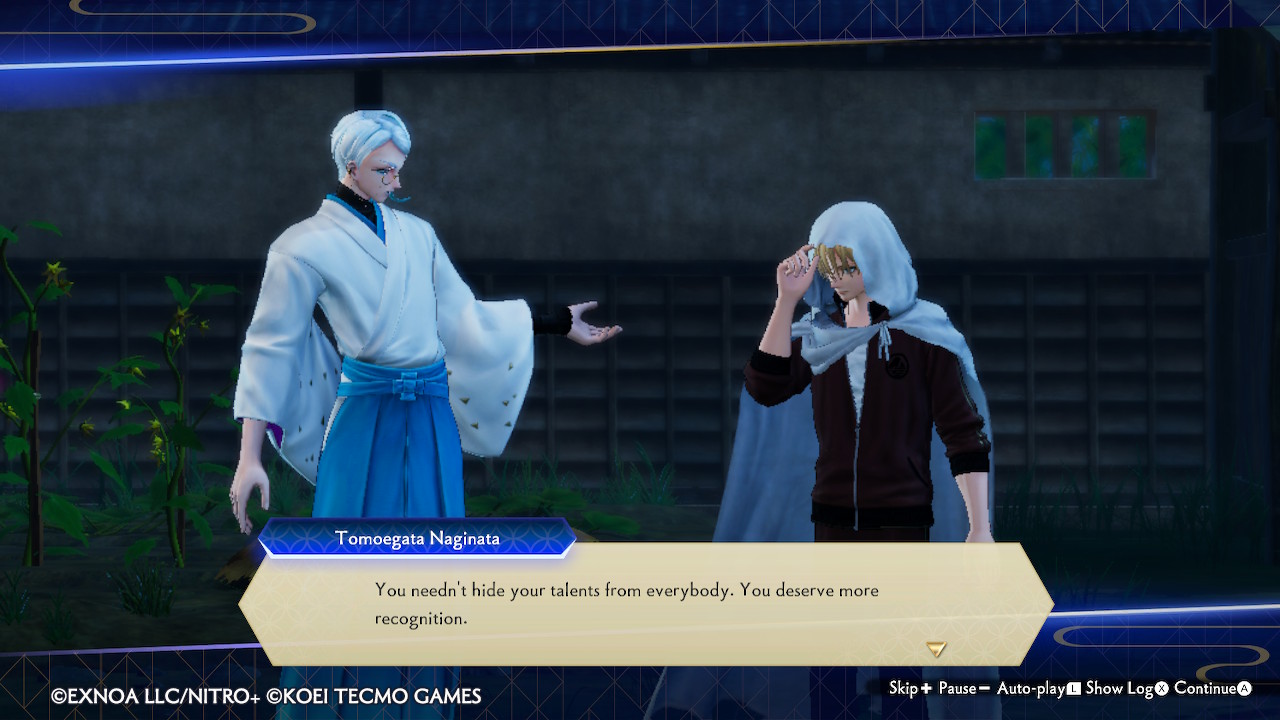Like most spin-offs, Touken Ranbu Warriors is at its best when building on the mechanics and ideas of its source material in ways that wouldn’t be possible in the original. Touken Ranbu Warriors takes Touken Ranbu -ONLINE-’s beloved Touken Danshi, human embodiments of the souls of Japanese swords, and seamlessly places them in a Warriors gameplay setting. Here, players take a more hands-on approach during missions and in the honmaru, bringing the world of Touken Ranbu to life in a refreshingly new way.
The main draw of any Warriors game—the hack-and-slash gameplay and missions—is where most of this magic happens. Players control one of 16 individual Touken Danshi—15 from the original browser game and one new character for Warriors—and plow through a substantial main game of over 100 missions. Each Touken Danshi’s unique attributes get featured through the gameplay, since they each have their own distinct fighting style. Even swords of the same classification don’t play remotely alike, from Tsurumaru’s light, airy combos to Ichigo’s precise, almost rapier-like swings.
In addition to stringing together normal attacks, a Special Attack can end a combo, and you can assign four Special Attacks of your choice to a button shortcut. These shortcuts add an extra layer of depth to battles since you can quickly select a Special Attack to respond to the current situation, such as landing a Crushing Blow to break an enemy’s shield. Still, it would have been nice if there was a practice mode of sorts to give players the opportunity to try out each of these Special Attacks before rushing headlong into an actual sortie; since each Touken Danshi plays so distinctly that even simpler Special Attacks such as the Straight Attack or Power Attack can differ significantly between characters, so you won’t know if you want to assign it to your shortcuts until you give it a try.
Special Attacks are among the numerous unlockable components in the Upgrade Abilities menu; unfortunately, they are the only major source of player expression in Touken Ranbu Warriors. Although the upgrading system would seem like the perfect place for more customization, it ultimately falls flat. You can use materials to unlock upgrades for each Touken Danshi, including stat increases, new Special Attacks, additional held item slots, and even increasing the number of normal moves they can combo together. While these are all very helpful, and especially critical in keeping everyone up-to-par in the later stages of the game, there’s very little difference between each Touken Danshi’s upgrades.
The stats that get increased may differ between sword types, but that’s the extent of their diversity. Additionally, you must unlock each node in one level to move to the next, offering no room for player expression. Instead, upgrading becomes its own kind of button mashing, going through each node until you run out of materials. Although maintaining enough materials for upgrading is itself a challenge, it’s not one that affects how you approach the game since there’s only one way to upgrade everyone.

Still, upgrades are crucial, and their effects can be clearly felt on the battlefield. Once in the midst of battle, it’s easy to get sucked into addictive hack-and-slash gameplay and forget the disappointingly simplistic upgrade system. The vast range of mission types available heightens the engrossing experience of directly controlling each Touken Danshi. From stealth missions, enemy-infested maze navigation, capture-the-bases, giant boss battles, and more, the breadth of mission types keeps gameplay interesting and helps flesh out the game’s story.
Touken Ranbu Warriors’s story successfully expands the ideas from Touken Ranbu -ONLINE-, cleverly using the missions to coincide with the overarching plot. By using missions to portray precisely how the Touken Danshi enact their sorties, Warriors further explores how the History Retrograde Army and relevant historical figures interact in the former’s attempts to alter history. Warriors’s story features compelling, multi-layered conflicts thanks to the appearance of the historical figures themselves, who experience struggles that the HRA can capitalize on. All the while, the Touken Danshi must delicately balance their responsibility to keep history intact with their own attachments to their beloved previous masters.
The storytelling always offers the necessary context so that anyone who may be familiar with the Touken Danshi but not their history can keep up with the unfolding plot; this is most notably the case with the storyline surrounding Omokage, the Warriors-original character who has no prior attachment to the world of Touken Ranbu. Omokage makes a fantastic addition to the cast with his intriguing subplot, and seeing him interact with and open up to the other Touken Danshi is immensely satisfying as a result.
All Touken Danshi get further chances to interact with each other through a whopping 259 total bond conversations—those in the same team get three conversations together, while everyone else gets two. What’s more, some of them, such as one between Tonbokiri and Muramasa, even reference the main storyline, ensuring they don’t all feel entirely disconnected from the severe tensions of Touken Ranbu Warriors‘s main plot. To increase the bond level between two Touken Danshi and unlock these charming dialogues, you can either send them to sortie together or pair them up around the honmaru.

The honmaru serves as the home base between battles where you can buy items, upgrade the Touken Danshi, replay previous missions, re-watch cutscenes, and more. You can also assign Touken Danshi to each area of the honmaru, allowing them to gain experience and bond levels together, as well as having them appear in those areas. It’s endearing to see them spend time with each other and liven up the honmaru in a way that is implied but not shown in Touken Ranbu -ONLINE-, but they could stand to interact with each other and their surroundings more than they do. Animations of the Touken Danshi tending to flowers in the garden or actually preparing food in the kitchen could really bring the honmaru activities to life, not to mention it would make taking photographs there a lot more interesting. Despite my captivation with taking pictures during sorties, my interest in taking photos in the honmaru diminished almost immediately since there are only so many unique picture possibilities when the Touken Danshi only idle in close proximity together.
There’s more activity to be found during honmaru minigames, which are available to play after returning from a sortie. They’re appropriately fast-paced and simple, from a quick-draw button matching game of karuta to timing alternating buttons for mochi pounding. Completing them results in various helpful rewards like additional materials and bond points, making them worth the time to play. But there are only two minigames per honmaru area, so they can start feeling a bit repetitive over time. More minigames (or more things to do in general around the honmaru, such as sparring, farming, and horse keeping like in Touken Ranbu -ONLINE-) could help alleviate this issue, as could increasing the length of the sorties. While the sorties don’t feel overly easy—I had a number of failed investigations and close calls myself—they do feel quite short. This gives Touken Ranbu Warriors a convenient “pick up and set down at your own leisure” appeal, but it also draws attention to the general lack of things to do at the honmaru.
But the bulk of the game’s action is, naturally, outside of the honmaru during sorties, and the the infinite photographic opportunities the missions provide accentuate the captivating gameplay. While I admit that I tend to take more screenshots during a single playthrough of any given game than most people would take in their entire lives, Touken Ranbu Warriors‘s picture mode offers a delightful additional way to interact with the Touken Danshi during missions, and I frequently find myself pausing the action to try to nab the perfect shot. There are a respectable number of options to play around with in photo mode, including filters, borders, and stickers, but it’s the visual prowess of Warriors that really elevates this feature.

The 2D designs of the Touken Danshi, illustrated by different artists in the original game, have translated very cohesively into 3D with drop-dead gorgeous character models. The characters are highly visible during battle no matter how many enemies surround them and regardless of the environment they find themselves in. Like the missions themselves, the maps in which the Touken Danshi exact their sorties encompass a massive range, with interiors and exteriors that both exhibit drastic lighting ranges. The maps are also alive with fantastical, colorful flora that make for stunning background elements. Other environmental details, such as books on shelves and foods and trinkets in marketplace stalls, are all fully rendered rather than flat textures on planes. There are plenty of particle effects, such as leaves and petals, that don’t hinder gameplay performance and serve as a delicate foreground element during battles and for taking pictures. Trusty Konnosuke also appears in maps to lead the way to the next location, cleverly giving him the chance to appear in photos while also ensuring players can keep their eyes on the battlefield at all times rather than needing to frequently dart back to the minimap.
Outside of missions and photos, Touken Ranbu Warriors’s beautiful graphics are put to good use through a surprisingly high number of pre-rendered cutscenes. In addition to exceptionally impressive graphical fidelity—especially for the Nintendo Switch—these cutscenes utilize beautiful cinematography and choreography, making them a joy to watch between missions. Even regular dialogue scenes can feel cinematic despite the limited number of character animations, thanks to clever camera use. It’s truly a delight to see the Touken Danshi come to life both through musou gameplay and Warriors’s storytelling and cutscenes.
Touken Ranbu Warriors offers exactly the kind of interaction between Touken Ranbu’s characters and musou mechanics that is only possible here, while maintaining the charm that makes the original property so beloved. Although some elements of the honmaru may not live up to the same high bar set by the missions, it’s still such a natural fit that the minor drawbacks seem less to disappoint and more to open up the possibility of future improvements. The ways Warriors intuitively expands the world of Touken Ranbu makes me excited for the possibility of other titles set across different time periods in Japan with the appropriate Touken Danshi and their previous masters. Although there’s no guarantee of what the future holds in that regard, I’ll happily return time and again to Touken Ranbu Warriors for its unique spin on the world of Touken Ranbu.


